FINANCE 10: Financial Analysis of Commonwealth Bank Report
VerifiedAdded on 2022/08/18
|15
|2466
|11
Report
AI Summary
This report presents a financial analysis of Commonwealth Bank, examining its performance from 2018 to 2019. The analysis employs various financial techniques, including ratio analysis (profitability, liquidity, capital structure, and efficiency ratios), Du Point analysis, and comparative analysis with National Australian Bank. The report assesses key financial metrics such as net profit margin, current ratio, debt ratio, and total asset turnover to evaluate the bank's financial health. Additionally, it delves into the relationship between capital structure and profitability, and provides insights into the current share price and P/E ratio. The conclusion summarizes the financial position of the bank, highlighting both strengths and potential challenges. The report also includes a summary of an article on APRA's role in regulating bankers' pay and remuneration systems, discussing the challenges faced by bank managers regarding employee remuneration and incentive structures, and suggesting strategies for addressing these issues.

Financial Management
Paraphrase This Document
Need a fresh take? Get an instant paraphrase of this document with our AI Paraphraser
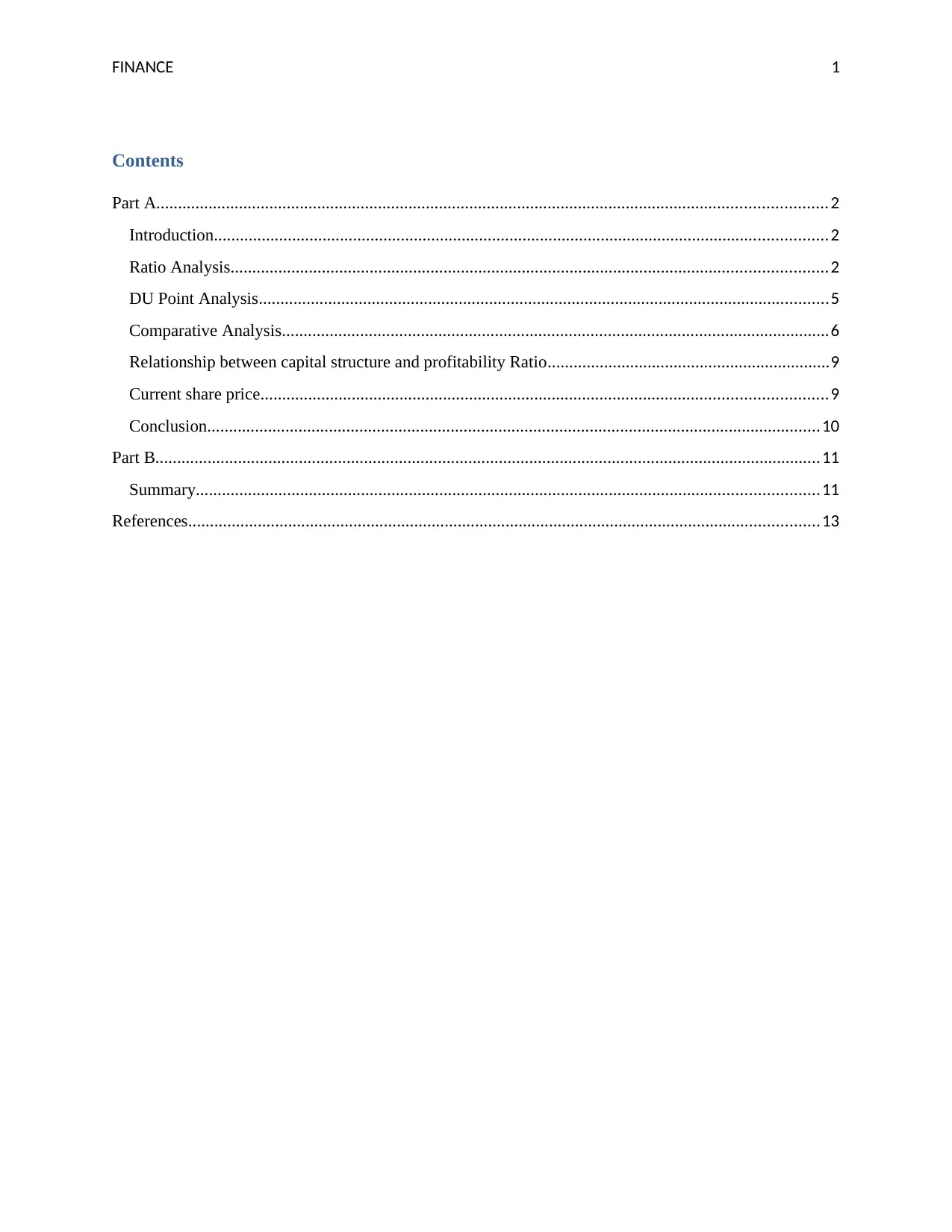
FINANCE 1
Contents
Part A..........................................................................................................................................................2
Introduction.............................................................................................................................................2
Ratio Analysis.........................................................................................................................................2
DU Point Analysis...................................................................................................................................5
Comparative Analysis..............................................................................................................................6
Relationship between capital structure and profitability Ratio.................................................................9
Current share price..................................................................................................................................9
Conclusion.............................................................................................................................................10
Part B.........................................................................................................................................................11
Summary...............................................................................................................................................11
References.................................................................................................................................................13
Contents
Part A..........................................................................................................................................................2
Introduction.............................................................................................................................................2
Ratio Analysis.........................................................................................................................................2
DU Point Analysis...................................................................................................................................5
Comparative Analysis..............................................................................................................................6
Relationship between capital structure and profitability Ratio.................................................................9
Current share price..................................................................................................................................9
Conclusion.............................................................................................................................................10
Part B.........................................................................................................................................................11
Summary...............................................................................................................................................11
References.................................................................................................................................................13

FINANCE 2
Part A
Introduction
Financial Analysis is the procedure of measuring the financial situation of the organization.
There are numerous techniques to evaluate the financial performance of the firm and these are
trend analysis, ratio analysis, Du point analysis and the others (Robinson, 2020). In this paper,
the financial analysis is taken as the topic to evaluate the financial situation of the organization.
Common Wealth Bank has been taken into consideration. Common Wealth Bank is an
Australian multinational bank that works the business in New Zealand, Asia, the United States
and the United Kingdom. It operates the business across Australia (The Commonwealth, 2018).
Ratio Analysis
Ratio Analysis of Common Wealth
Bank
Trend
Analysis
2018 2019
Profitability Ratio
Net profit Margin Net Profit 9,329,000 8,571,000
Net Sales 24,818,000 23,153,000
38% 37% -2%
From the above discussion, it has been estimated that the net profit margin of Common Wealth
Bank has been decreases from the previous year by -2% as it is 38% in 2018 and 37% in 2019.
The trend analysis states the negative amount of percentage depicts that the company
Part A
Introduction
Financial Analysis is the procedure of measuring the financial situation of the organization.
There are numerous techniques to evaluate the financial performance of the firm and these are
trend analysis, ratio analysis, Du point analysis and the others (Robinson, 2020). In this paper,
the financial analysis is taken as the topic to evaluate the financial situation of the organization.
Common Wealth Bank has been taken into consideration. Common Wealth Bank is an
Australian multinational bank that works the business in New Zealand, Asia, the United States
and the United Kingdom. It operates the business across Australia (The Commonwealth, 2018).
Ratio Analysis
Ratio Analysis of Common Wealth
Bank
Trend
Analysis
2018 2019
Profitability Ratio
Net profit Margin Net Profit 9,329,000 8,571,000
Net Sales 24,818,000 23,153,000
38% 37% -2%
From the above discussion, it has been estimated that the net profit margin of Common Wealth
Bank has been decreases from the previous year by -2% as it is 38% in 2018 and 37% in 2019.
The trend analysis states the negative amount of percentage depicts that the company
⊘ This is a preview!⊘
Do you want full access?
Subscribe today to unlock all pages.

Trusted by 1+ million students worldwide
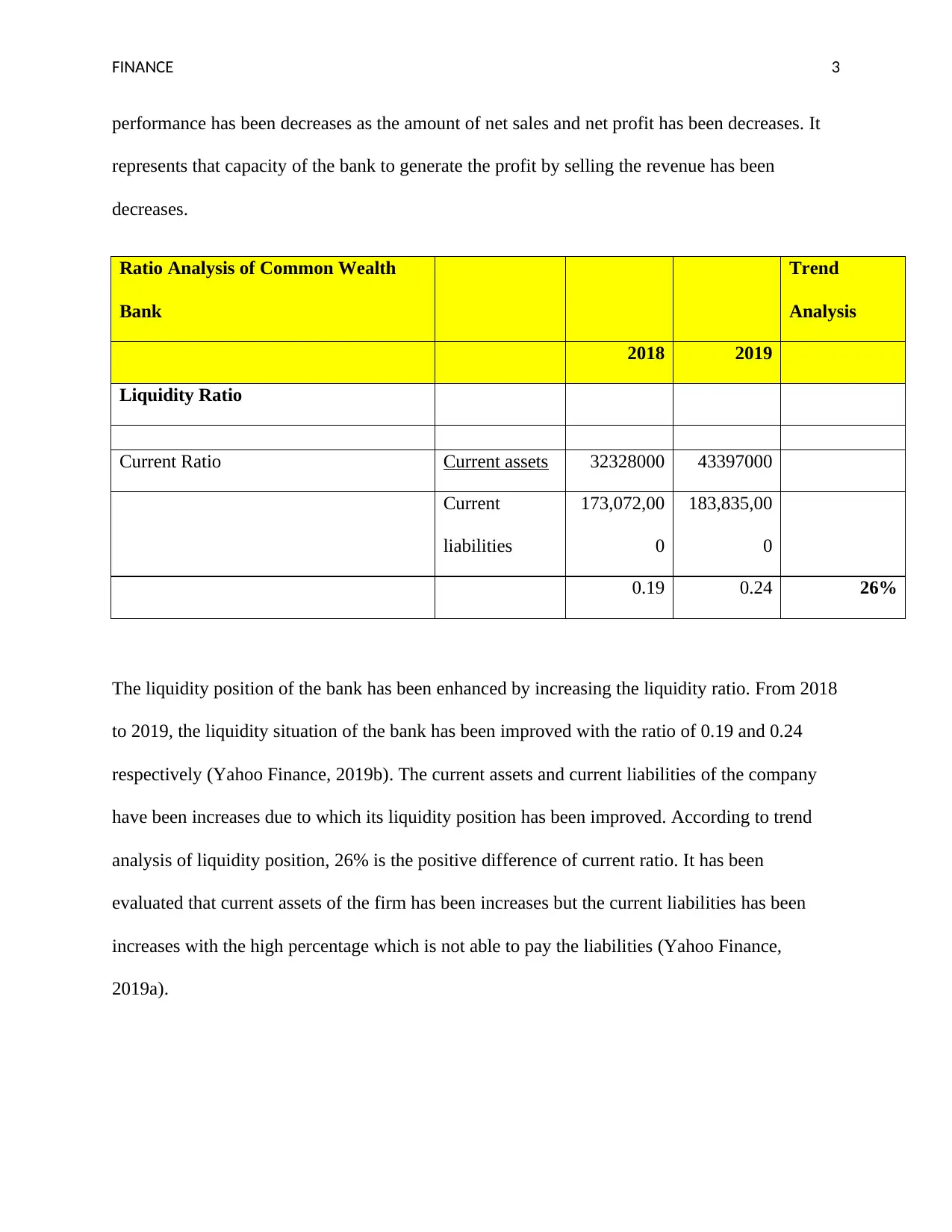
FINANCE 3
performance has been decreases as the amount of net sales and net profit has been decreases. It
represents that capacity of the bank to generate the profit by selling the revenue has been
decreases.
Ratio Analysis of Common Wealth
Bank
Trend
Analysis
2018 2019
Liquidity Ratio
Current Ratio Current assets 32328000 43397000
Current
liabilities
173,072,00
0
183,835,00
0
0.19 0.24 26%
The liquidity position of the bank has been enhanced by increasing the liquidity ratio. From 2018
to 2019, the liquidity situation of the bank has been improved with the ratio of 0.19 and 0.24
respectively (Yahoo Finance, 2019b). The current assets and current liabilities of the company
have been increases due to which its liquidity position has been improved. According to trend
analysis of liquidity position, 26% is the positive difference of current ratio. It has been
evaluated that current assets of the firm has been increases but the current liabilities has been
increases with the high percentage which is not able to pay the liabilities (Yahoo Finance,
2019a).
performance has been decreases as the amount of net sales and net profit has been decreases. It
represents that capacity of the bank to generate the profit by selling the revenue has been
decreases.
Ratio Analysis of Common Wealth
Bank
Trend
Analysis
2018 2019
Liquidity Ratio
Current Ratio Current assets 32328000 43397000
Current
liabilities
173,072,00
0
183,835,00
0
0.19 0.24 26%
The liquidity position of the bank has been enhanced by increasing the liquidity ratio. From 2018
to 2019, the liquidity situation of the bank has been improved with the ratio of 0.19 and 0.24
respectively (Yahoo Finance, 2019b). The current assets and current liabilities of the company
have been increases due to which its liquidity position has been improved. According to trend
analysis of liquidity position, 26% is the positive difference of current ratio. It has been
evaluated that current assets of the firm has been increases but the current liabilities has been
increases with the high percentage which is not able to pay the liabilities (Yahoo Finance,
2019a).
Paraphrase This Document
Need a fresh take? Get an instant paraphrase of this document with our AI Paraphraser

FINANCE 4
Ratio Analysis of Common Wealth
Bank
Trend
Analysis
2018 2019
Capital Structure :
Debt Ratio Total Debt
907,305,00
0
906,853,00
0
Total Asset
975,165,00
0
976,502,00
0
0.93 0.93 -0.2%
As per the analysis of capital structure of the bank, it is observed that debt ratio is constant in
both the years. According to trend analysis of the ratios, it has been estimated that there is -0.2%
of change in two years such as 2018 and 2019. It states that the liabilities have been decreases
and the amount of total assets has been increases with the minor percentage due to which its
capital structure has been improved (Storey, Keasey, Watson, and Wynarczyk, 2016). The
improving capital structure depicts that the bank has the capacity to pay all liabilities by using
the assets as the amount of total assets is high as compare to liabilities. The debt ratios of both
the years are 0.93 as the liabilities and assets has been decreases or increases with the minor
percentage (Yahoo Finance, 2019a).
Ratio Analysis of Common
Wealth Bank
Trend
Analysis
2018 2019
Ratio Analysis of Common Wealth
Bank
Trend
Analysis
2018 2019
Capital Structure :
Debt Ratio Total Debt
907,305,00
0
906,853,00
0
Total Asset
975,165,00
0
976,502,00
0
0.93 0.93 -0.2%
As per the analysis of capital structure of the bank, it is observed that debt ratio is constant in
both the years. According to trend analysis of the ratios, it has been estimated that there is -0.2%
of change in two years such as 2018 and 2019. It states that the liabilities have been decreases
and the amount of total assets has been increases with the minor percentage due to which its
capital structure has been improved (Storey, Keasey, Watson, and Wynarczyk, 2016). The
improving capital structure depicts that the bank has the capacity to pay all liabilities by using
the assets as the amount of total assets is high as compare to liabilities. The debt ratios of both
the years are 0.93 as the liabilities and assets has been decreases or increases with the minor
percentage (Yahoo Finance, 2019a).
Ratio Analysis of Common
Wealth Bank
Trend
Analysis
2018 2019
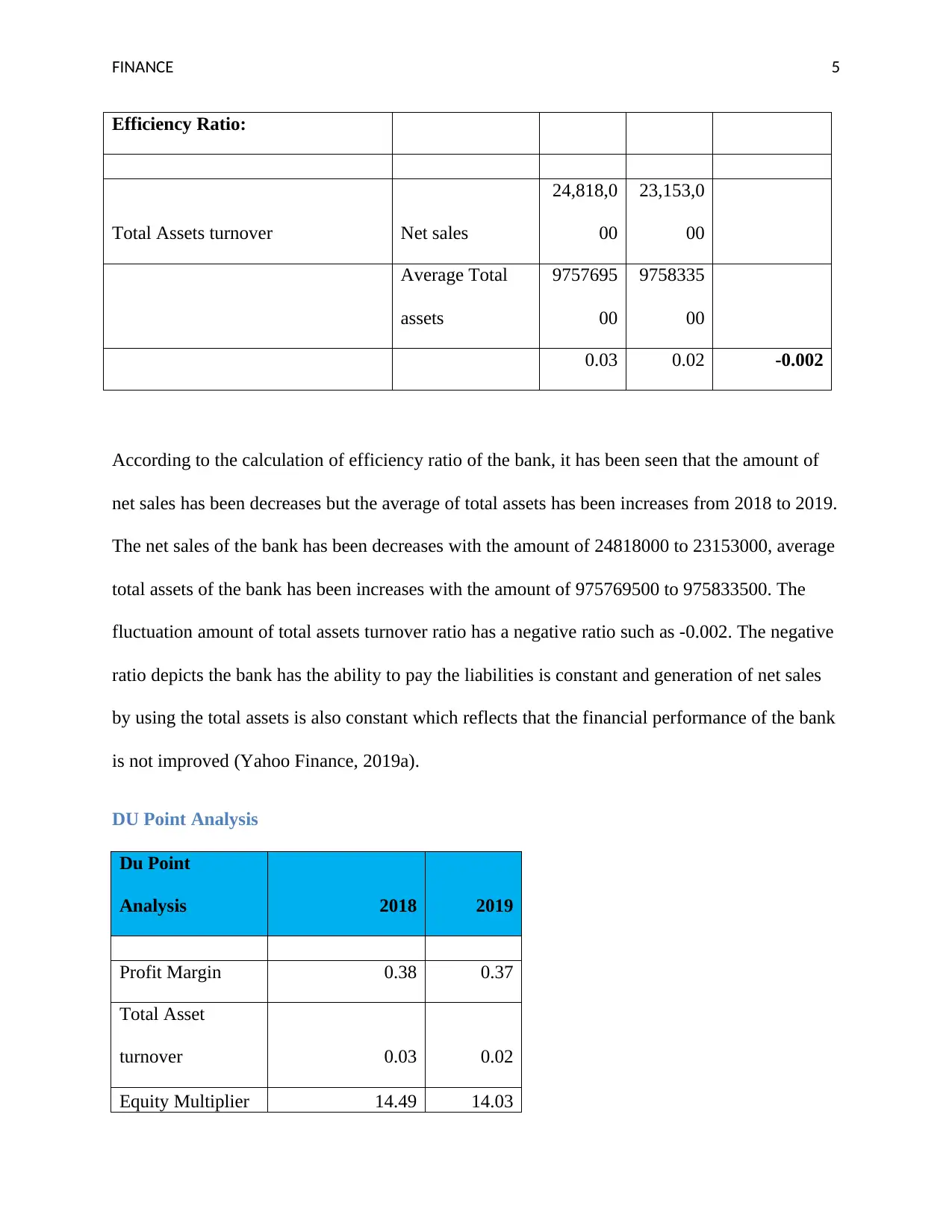
FINANCE 5
Efficiency Ratio:
Total Assets turnover Net sales
24,818,0
00
23,153,0
00
Average Total
assets
9757695
00
9758335
00
0.03 0.02 -0.002
According to the calculation of efficiency ratio of the bank, it has been seen that the amount of
net sales has been decreases but the average of total assets has been increases from 2018 to 2019.
The net sales of the bank has been decreases with the amount of 24818000 to 23153000, average
total assets of the bank has been increases with the amount of 975769500 to 975833500. The
fluctuation amount of total assets turnover ratio has a negative ratio such as -0.002. The negative
ratio depicts the bank has the ability to pay the liabilities is constant and generation of net sales
by using the total assets is also constant which reflects that the financial performance of the bank
is not improved (Yahoo Finance, 2019a).
DU Point Analysis
Du Point
Analysis 2018 2019
Profit Margin 0.38 0.37
Total Asset
turnover 0.03 0.02
Equity Multiplier 14.49 14.03
Efficiency Ratio:
Total Assets turnover Net sales
24,818,0
00
23,153,0
00
Average Total
assets
9757695
00
9758335
00
0.03 0.02 -0.002
According to the calculation of efficiency ratio of the bank, it has been seen that the amount of
net sales has been decreases but the average of total assets has been increases from 2018 to 2019.
The net sales of the bank has been decreases with the amount of 24818000 to 23153000, average
total assets of the bank has been increases with the amount of 975769500 to 975833500. The
fluctuation amount of total assets turnover ratio has a negative ratio such as -0.002. The negative
ratio depicts the bank has the ability to pay the liabilities is constant and generation of net sales
by using the total assets is also constant which reflects that the financial performance of the bank
is not improved (Yahoo Finance, 2019a).
DU Point Analysis
Du Point
Analysis 2018 2019
Profit Margin 0.38 0.37
Total Asset
turnover 0.03 0.02
Equity Multiplier 14.49 14.03
⊘ This is a preview!⊘
Do you want full access?
Subscribe today to unlock all pages.

Trusted by 1+ million students worldwide
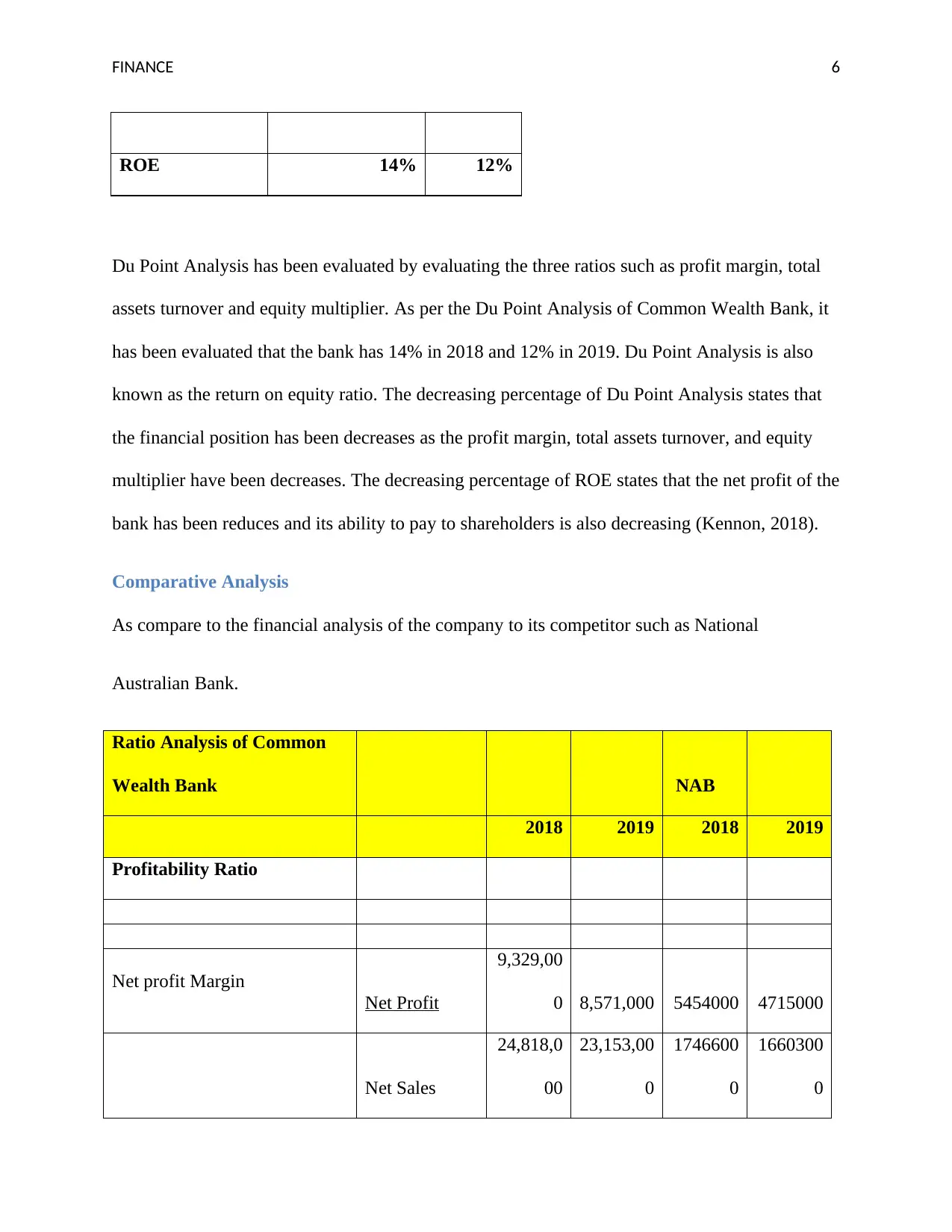
FINANCE 6
ROE 14% 12%
Du Point Analysis has been evaluated by evaluating the three ratios such as profit margin, total
assets turnover and equity multiplier. As per the Du Point Analysis of Common Wealth Bank, it
has been evaluated that the bank has 14% in 2018 and 12% in 2019. Du Point Analysis is also
known as the return on equity ratio. The decreasing percentage of Du Point Analysis states that
the financial position has been decreases as the profit margin, total assets turnover, and equity
multiplier have been decreases. The decreasing percentage of ROE states that the net profit of the
bank has been reduces and its ability to pay to shareholders is also decreasing (Kennon, 2018).
Comparative Analysis
As compare to the financial analysis of the company to its competitor such as National
Australian Bank.
Ratio Analysis of Common
Wealth Bank NAB
2018 2019 2018 2019
Profitability Ratio
Net profit Margin
Net Profit
9,329,00
0 8,571,000 5454000 4715000
Net Sales
24,818,0
00
23,153,00
0
1746600
0
1660300
0
ROE 14% 12%
Du Point Analysis has been evaluated by evaluating the three ratios such as profit margin, total
assets turnover and equity multiplier. As per the Du Point Analysis of Common Wealth Bank, it
has been evaluated that the bank has 14% in 2018 and 12% in 2019. Du Point Analysis is also
known as the return on equity ratio. The decreasing percentage of Du Point Analysis states that
the financial position has been decreases as the profit margin, total assets turnover, and equity
multiplier have been decreases. The decreasing percentage of ROE states that the net profit of the
bank has been reduces and its ability to pay to shareholders is also decreasing (Kennon, 2018).
Comparative Analysis
As compare to the financial analysis of the company to its competitor such as National
Australian Bank.
Ratio Analysis of Common
Wealth Bank NAB
2018 2019 2018 2019
Profitability Ratio
Net profit Margin
Net Profit
9,329,00
0 8,571,000 5454000 4715000
Net Sales
24,818,0
00
23,153,00
0
1746600
0
1660300
0
Paraphrase This Document
Need a fresh take? Get an instant paraphrase of this document with our AI Paraphraser
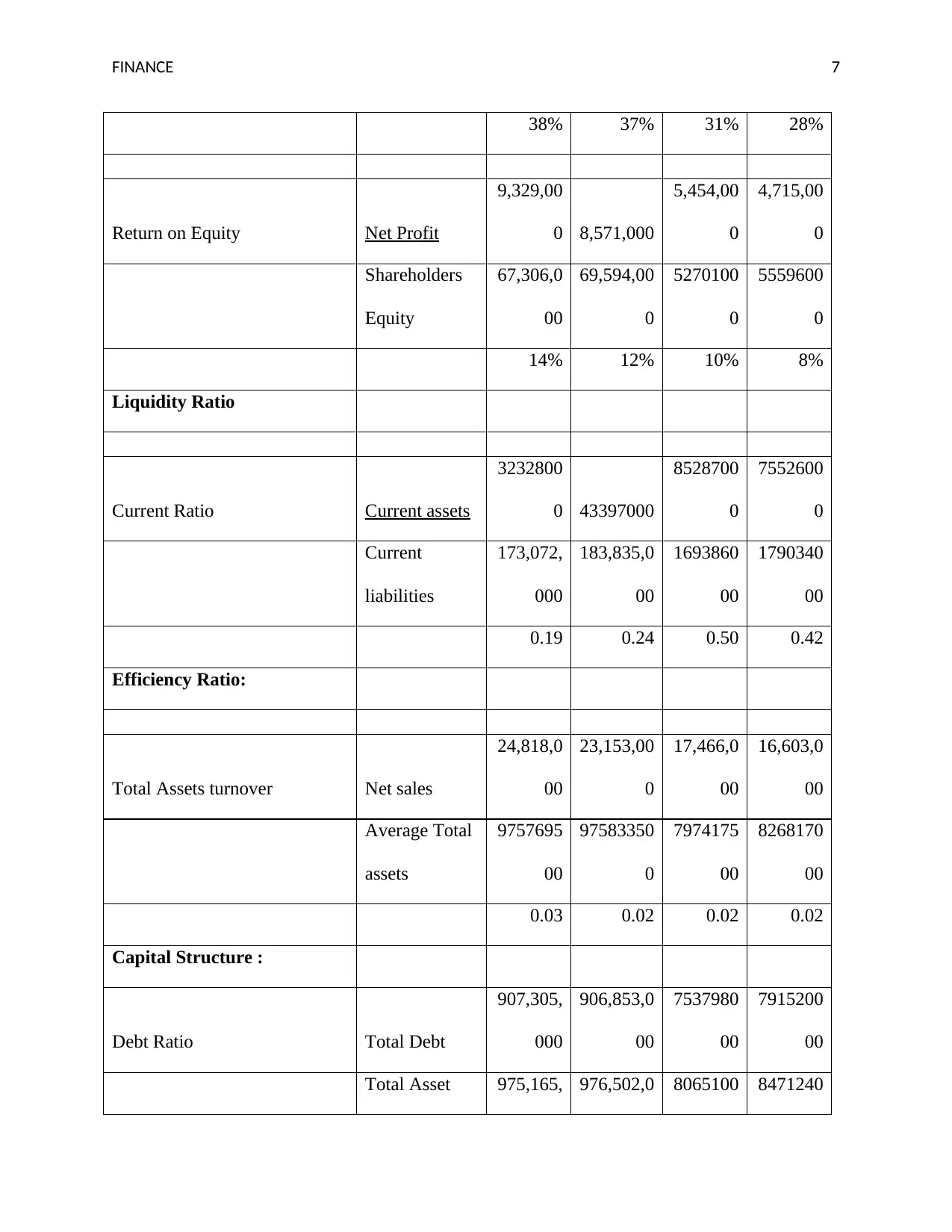
FINANCE 7
38% 37% 31% 28%
Return on Equity Net Profit
9,329,00
0 8,571,000
5,454,00
0
4,715,00
0
Shareholders
Equity
67,306,0
00
69,594,00
0
5270100
0
5559600
0
14% 12% 10% 8%
Liquidity Ratio
Current Ratio Current assets
3232800
0 43397000
8528700
0
7552600
0
Current
liabilities
173,072,
000
183,835,0
00
1693860
00
1790340
00
0.19 0.24 0.50 0.42
Efficiency Ratio:
Total Assets turnover Net sales
24,818,0
00
23,153,00
0
17,466,0
00
16,603,0
00
Average Total
assets
9757695
00
97583350
0
7974175
00
8268170
00
0.03 0.02 0.02 0.02
Capital Structure :
Debt Ratio Total Debt
907,305,
000
906,853,0
00
7537980
00
7915200
00
Total Asset 975,165, 976,502,0 8065100 8471240
38% 37% 31% 28%
Return on Equity Net Profit
9,329,00
0 8,571,000
5,454,00
0
4,715,00
0
Shareholders
Equity
67,306,0
00
69,594,00
0
5270100
0
5559600
0
14% 12% 10% 8%
Liquidity Ratio
Current Ratio Current assets
3232800
0 43397000
8528700
0
7552600
0
Current
liabilities
173,072,
000
183,835,0
00
1693860
00
1790340
00
0.19 0.24 0.50 0.42
Efficiency Ratio:
Total Assets turnover Net sales
24,818,0
00
23,153,00
0
17,466,0
00
16,603,0
00
Average Total
assets
9757695
00
97583350
0
7974175
00
8268170
00
0.03 0.02 0.02 0.02
Capital Structure :
Debt Ratio Total Debt
907,305,
000
906,853,0
00
7537980
00
7915200
00
Total Asset 975,165, 976,502,0 8065100 8471240
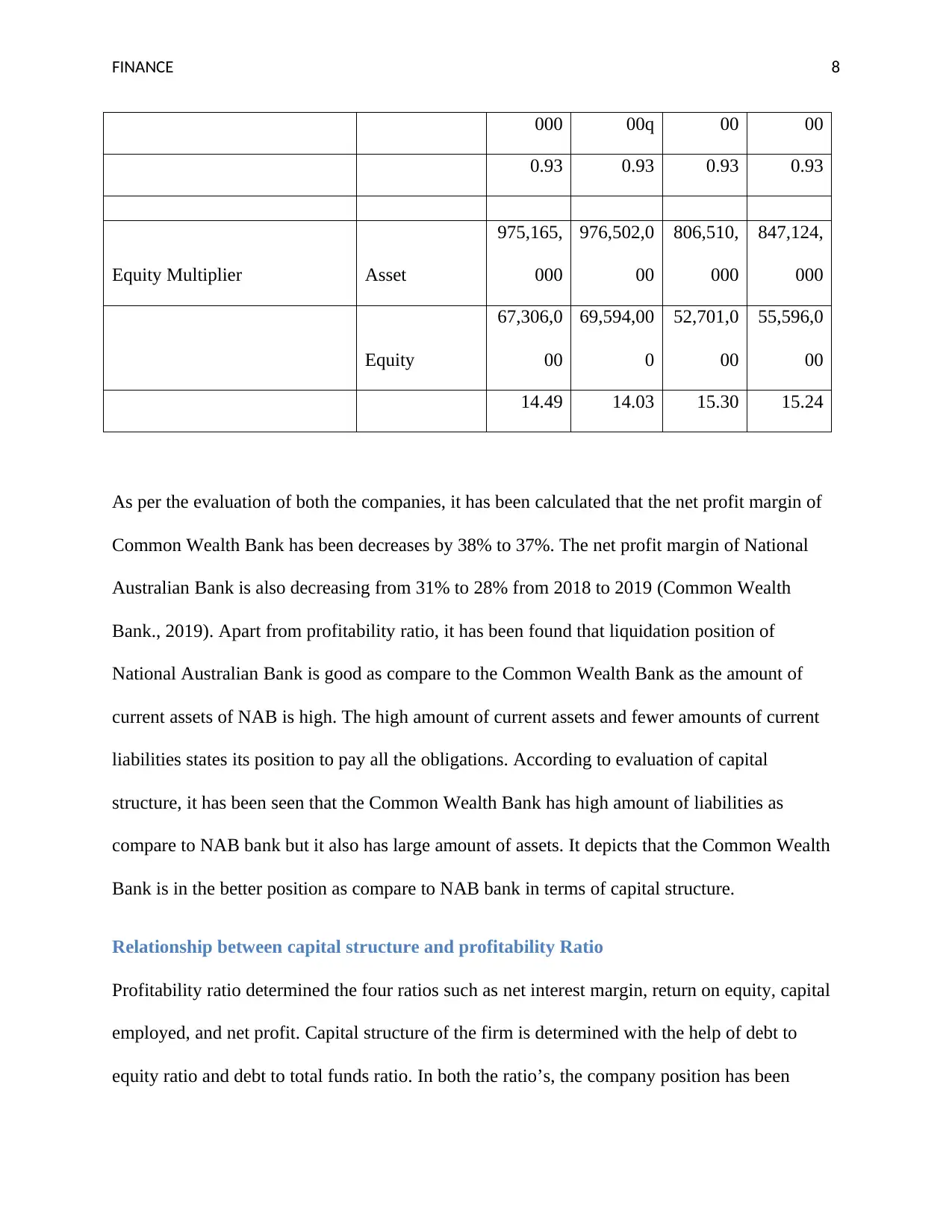
FINANCE 8
000 00q 00 00
0.93 0.93 0.93 0.93
Equity Multiplier Asset
975,165,
000
976,502,0
00
806,510,
000
847,124,
000
Equity
67,306,0
00
69,594,00
0
52,701,0
00
55,596,0
00
14.49 14.03 15.30 15.24
As per the evaluation of both the companies, it has been calculated that the net profit margin of
Common Wealth Bank has been decreases by 38% to 37%. The net profit margin of National
Australian Bank is also decreasing from 31% to 28% from 2018 to 2019 (Common Wealth
Bank., 2019). Apart from profitability ratio, it has been found that liquidation position of
National Australian Bank is good as compare to the Common Wealth Bank as the amount of
current assets of NAB is high. The high amount of current assets and fewer amounts of current
liabilities states its position to pay all the obligations. According to evaluation of capital
structure, it has been seen that the Common Wealth Bank has high amount of liabilities as
compare to NAB bank but it also has large amount of assets. It depicts that the Common Wealth
Bank is in the better position as compare to NAB bank in terms of capital structure.
Relationship between capital structure and profitability Ratio
Profitability ratio determined the four ratios such as net interest margin, return on equity, capital
employed, and net profit. Capital structure of the firm is determined with the help of debt to
equity ratio and debt to total funds ratio. In both the ratio’s, the company position has been
000 00q 00 00
0.93 0.93 0.93 0.93
Equity Multiplier Asset
975,165,
000
976,502,0
00
806,510,
000
847,124,
000
Equity
67,306,0
00
69,594,00
0
52,701,0
00
55,596,0
00
14.49 14.03 15.30 15.24
As per the evaluation of both the companies, it has been calculated that the net profit margin of
Common Wealth Bank has been decreases by 38% to 37%. The net profit margin of National
Australian Bank is also decreasing from 31% to 28% from 2018 to 2019 (Common Wealth
Bank., 2019). Apart from profitability ratio, it has been found that liquidation position of
National Australian Bank is good as compare to the Common Wealth Bank as the amount of
current assets of NAB is high. The high amount of current assets and fewer amounts of current
liabilities states its position to pay all the obligations. According to evaluation of capital
structure, it has been seen that the Common Wealth Bank has high amount of liabilities as
compare to NAB bank but it also has large amount of assets. It depicts that the Common Wealth
Bank is in the better position as compare to NAB bank in terms of capital structure.
Relationship between capital structure and profitability Ratio
Profitability ratio determined the four ratios such as net interest margin, return on equity, capital
employed, and net profit. Capital structure of the firm is determined with the help of debt to
equity ratio and debt to total funds ratio. In both the ratio’s, the company position has been
⊘ This is a preview!⊘
Do you want full access?
Subscribe today to unlock all pages.

Trusted by 1+ million students worldwide
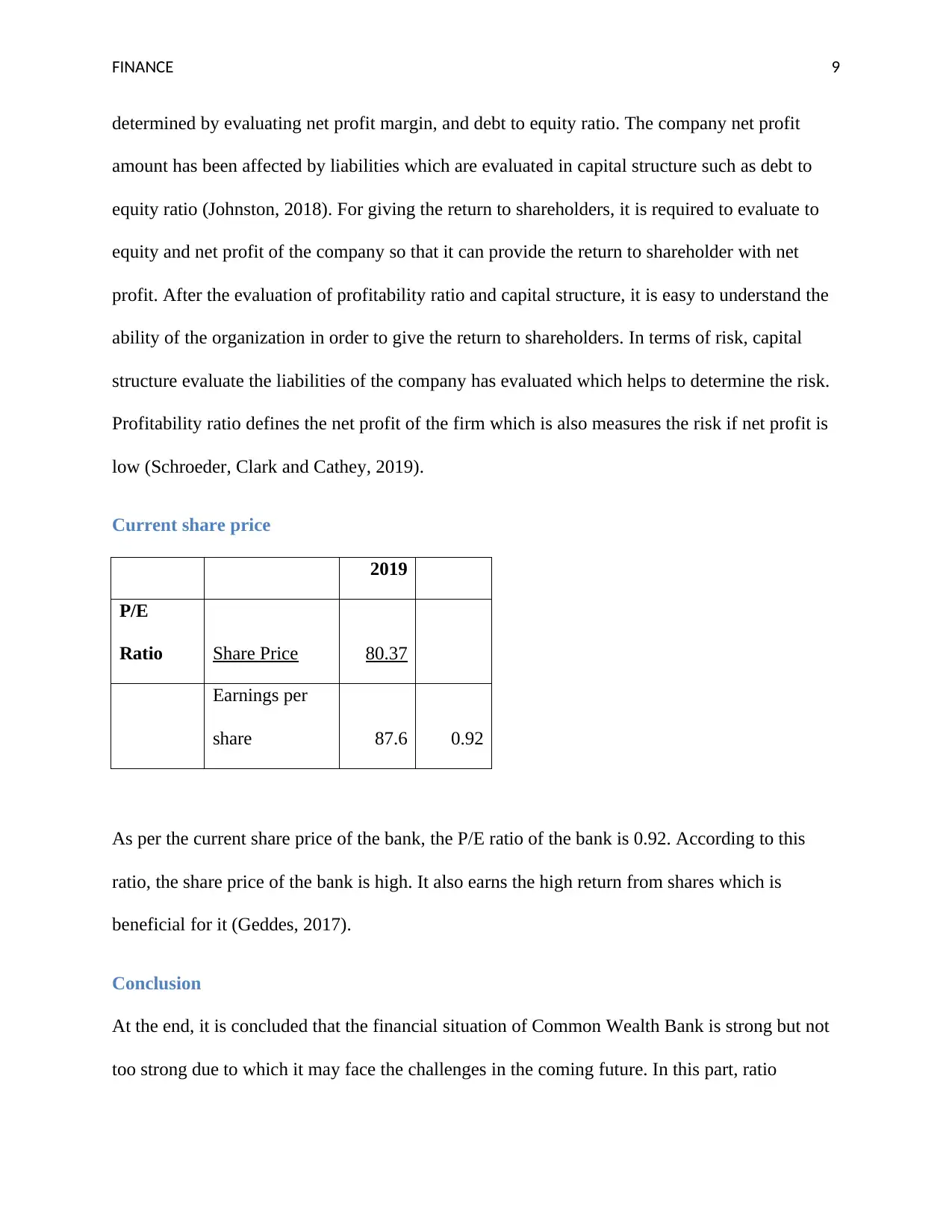
FINANCE 9
determined by evaluating net profit margin, and debt to equity ratio. The company net profit
amount has been affected by liabilities which are evaluated in capital structure such as debt to
equity ratio (Johnston, 2018). For giving the return to shareholders, it is required to evaluate to
equity and net profit of the company so that it can provide the return to shareholder with net
profit. After the evaluation of profitability ratio and capital structure, it is easy to understand the
ability of the organization in order to give the return to shareholders. In terms of risk, capital
structure evaluate the liabilities of the company has evaluated which helps to determine the risk.
Profitability ratio defines the net profit of the firm which is also measures the risk if net profit is
low (Schroeder, Clark and Cathey, 2019).
Current share price
2019
P/E
Ratio Share Price 80.37
Earnings per
share 87.6 0.92
As per the current share price of the bank, the P/E ratio of the bank is 0.92. According to this
ratio, the share price of the bank is high. It also earns the high return from shares which is
beneficial for it (Geddes, 2017).
Conclusion
At the end, it is concluded that the financial situation of Common Wealth Bank is strong but not
too strong due to which it may face the challenges in the coming future. In this part, ratio
determined by evaluating net profit margin, and debt to equity ratio. The company net profit
amount has been affected by liabilities which are evaluated in capital structure such as debt to
equity ratio (Johnston, 2018). For giving the return to shareholders, it is required to evaluate to
equity and net profit of the company so that it can provide the return to shareholder with net
profit. After the evaluation of profitability ratio and capital structure, it is easy to understand the
ability of the organization in order to give the return to shareholders. In terms of risk, capital
structure evaluate the liabilities of the company has evaluated which helps to determine the risk.
Profitability ratio defines the net profit of the firm which is also measures the risk if net profit is
low (Schroeder, Clark and Cathey, 2019).
Current share price
2019
P/E
Ratio Share Price 80.37
Earnings per
share 87.6 0.92
As per the current share price of the bank, the P/E ratio of the bank is 0.92. According to this
ratio, the share price of the bank is high. It also earns the high return from shares which is
beneficial for it (Geddes, 2017).
Conclusion
At the end, it is concluded that the financial situation of Common Wealth Bank is strong but not
too strong due to which it may face the challenges in the coming future. In this part, ratio
Paraphrase This Document
Need a fresh take? Get an instant paraphrase of this document with our AI Paraphraser
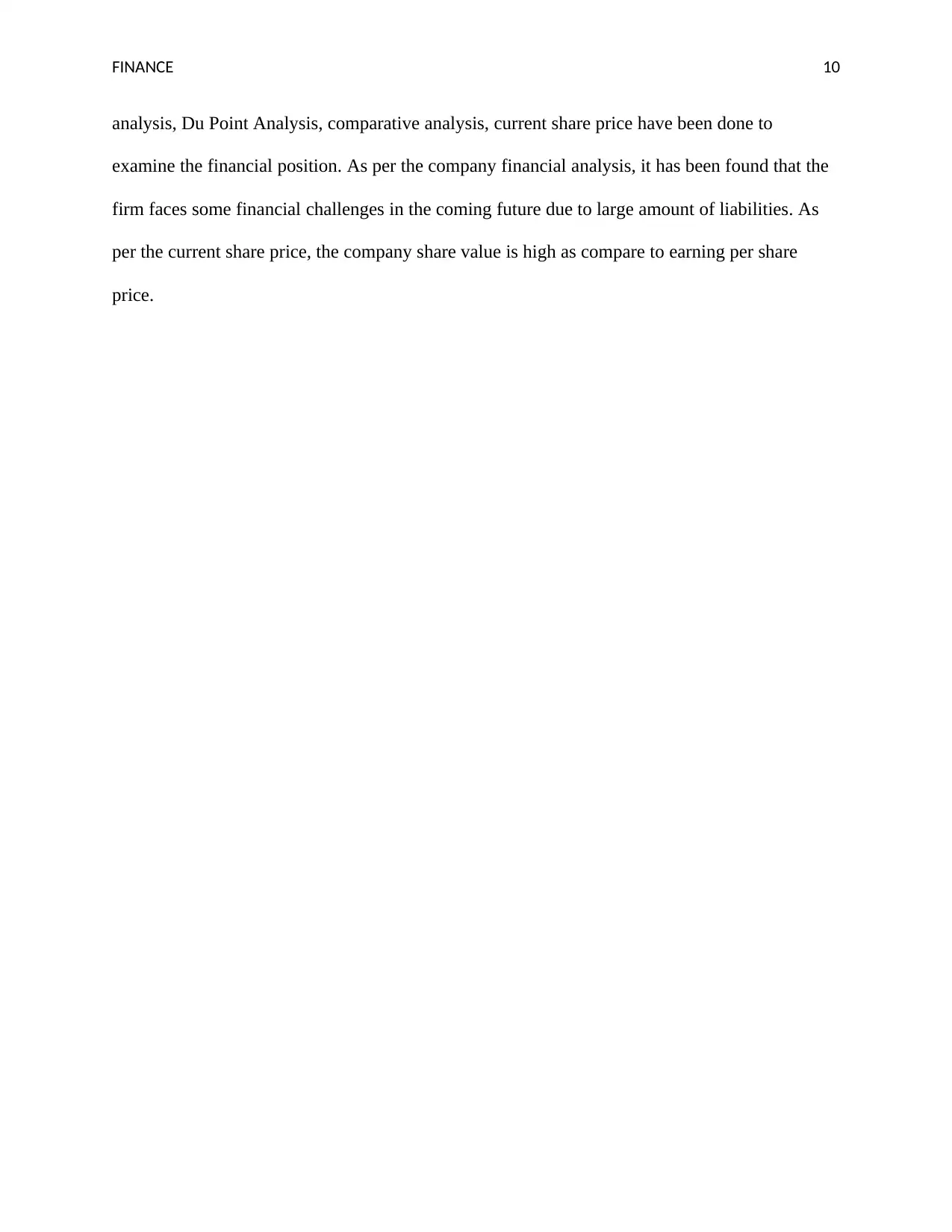
FINANCE 10
analysis, Du Point Analysis, comparative analysis, current share price have been done to
examine the financial position. As per the company financial analysis, it has been found that the
firm faces some financial challenges in the coming future due to large amount of liabilities. As
per the current share price, the company share value is high as compare to earning per share
price.
analysis, Du Point Analysis, comparative analysis, current share price have been done to
examine the financial position. As per the company financial analysis, it has been found that the
firm faces some financial challenges in the coming future due to large amount of liabilities. As
per the current share price, the company share value is high as compare to earning per share
price.
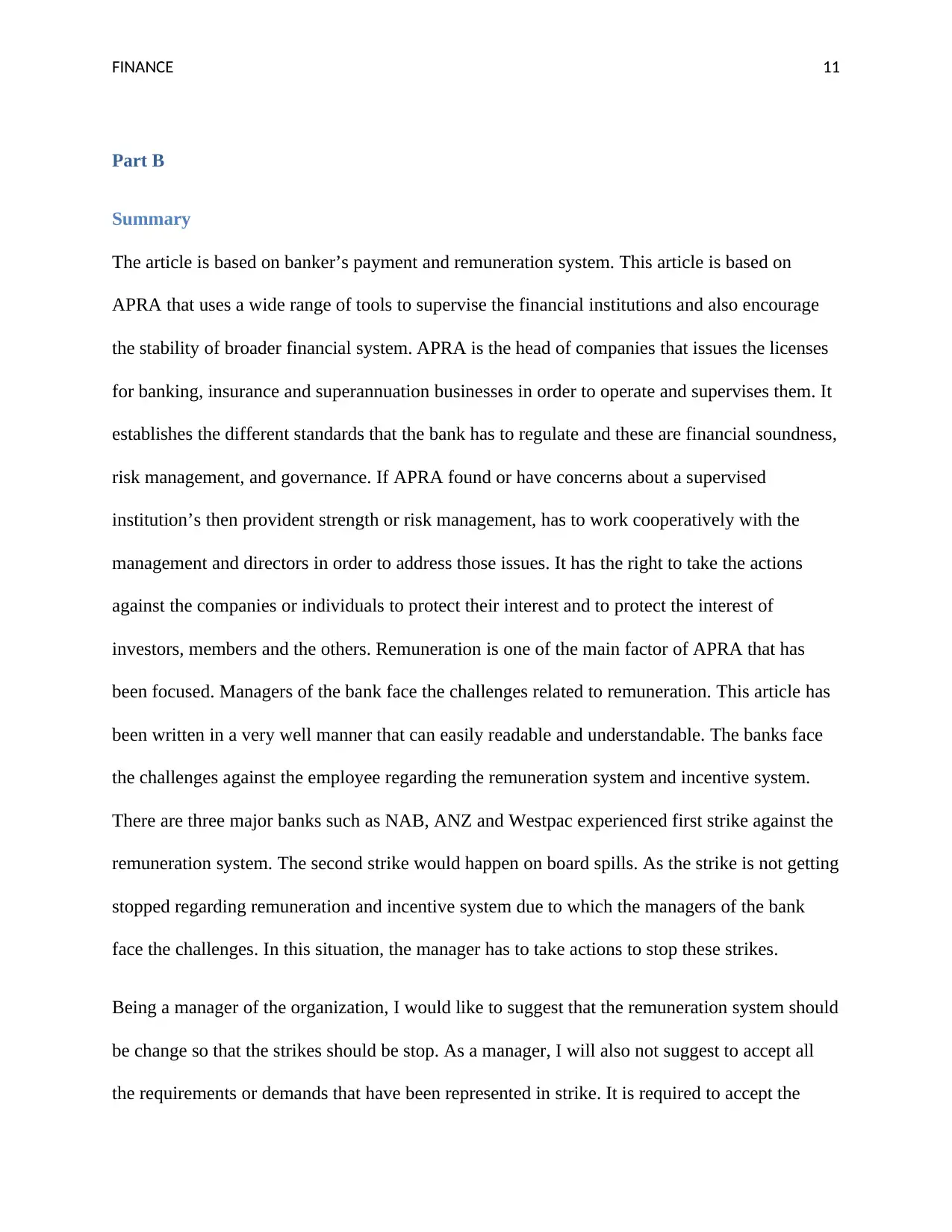
FINANCE 11
Part B
Summary
The article is based on banker’s payment and remuneration system. This article is based on
APRA that uses a wide range of tools to supervise the financial institutions and also encourage
the stability of broader financial system. APRA is the head of companies that issues the licenses
for banking, insurance and superannuation businesses in order to operate and supervises them. It
establishes the different standards that the bank has to regulate and these are financial soundness,
risk management, and governance. If APRA found or have concerns about a supervised
institution’s then provident strength or risk management, has to work cooperatively with the
management and directors in order to address those issues. It has the right to take the actions
against the companies or individuals to protect their interest and to protect the interest of
investors, members and the others. Remuneration is one of the main factor of APRA that has
been focused. Managers of the bank face the challenges related to remuneration. This article has
been written in a very well manner that can easily readable and understandable. The banks face
the challenges against the employee regarding the remuneration system and incentive system.
There are three major banks such as NAB, ANZ and Westpac experienced first strike against the
remuneration system. The second strike would happen on board spills. As the strike is not getting
stopped regarding remuneration and incentive system due to which the managers of the bank
face the challenges. In this situation, the manager has to take actions to stop these strikes.
Being a manager of the organization, I would like to suggest that the remuneration system should
be change so that the strikes should be stop. As a manager, I will also not suggest to accept all
the requirements or demands that have been represented in strike. It is required to accept the
Part B
Summary
The article is based on banker’s payment and remuneration system. This article is based on
APRA that uses a wide range of tools to supervise the financial institutions and also encourage
the stability of broader financial system. APRA is the head of companies that issues the licenses
for banking, insurance and superannuation businesses in order to operate and supervises them. It
establishes the different standards that the bank has to regulate and these are financial soundness,
risk management, and governance. If APRA found or have concerns about a supervised
institution’s then provident strength or risk management, has to work cooperatively with the
management and directors in order to address those issues. It has the right to take the actions
against the companies or individuals to protect their interest and to protect the interest of
investors, members and the others. Remuneration is one of the main factor of APRA that has
been focused. Managers of the bank face the challenges related to remuneration. This article has
been written in a very well manner that can easily readable and understandable. The banks face
the challenges against the employee regarding the remuneration system and incentive system.
There are three major banks such as NAB, ANZ and Westpac experienced first strike against the
remuneration system. The second strike would happen on board spills. As the strike is not getting
stopped regarding remuneration and incentive system due to which the managers of the bank
face the challenges. In this situation, the manager has to take actions to stop these strikes.
Being a manager of the organization, I would like to suggest that the remuneration system should
be change so that the strikes should be stop. As a manager, I will also not suggest to accept all
the requirements or demands that have been represented in strike. It is required to accept the
⊘ This is a preview!⊘
Do you want full access?
Subscribe today to unlock all pages.

Trusted by 1+ million students worldwide
1 out of 15
Related Documents
Your All-in-One AI-Powered Toolkit for Academic Success.
+13062052269
info@desklib.com
Available 24*7 on WhatsApp / Email
![[object Object]](/_next/static/media/star-bottom.7253800d.svg)
Unlock your academic potential
Copyright © 2020–2025 A2Z Services. All Rights Reserved. Developed and managed by ZUCOL.





